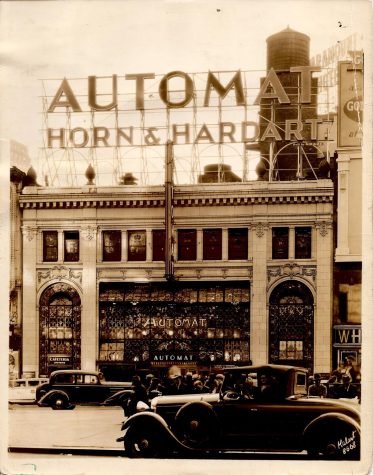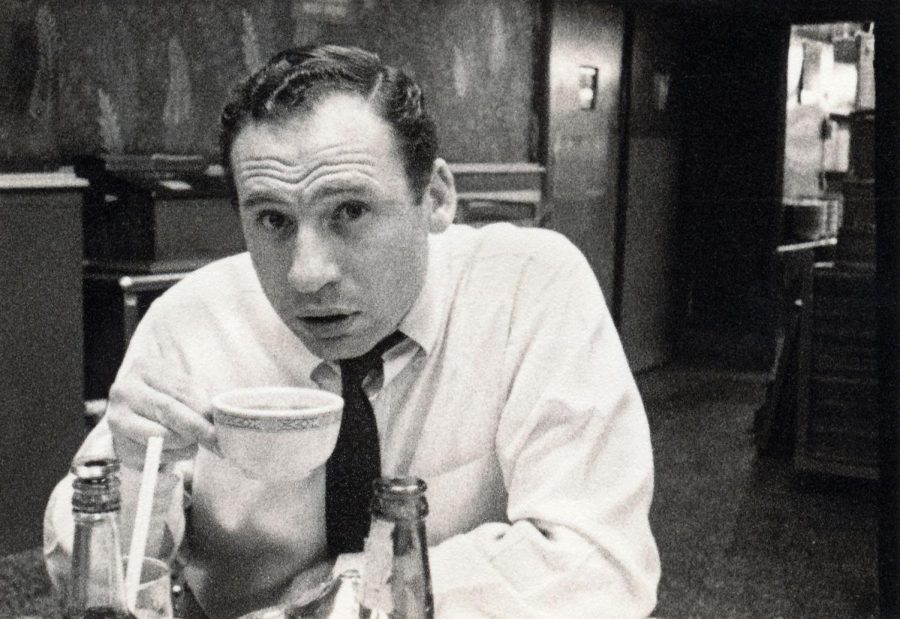Jewish Film Festival documentary ‘The Automat’ serves up pure charm
Mel Brooks drinking coffee photographed by Carl Reiner while the two were writers for Your Show of Shows, c. 1950-1954 in The Automat. Photo courtesy of A Slice of Pie Productions
Published February 28, 2022
Mel Brooks, Ruth Bader Ginsberg, Colin Powell, Carl Reiner and Elliot Gould were all fans of the Automat, the iconic automated cafeterias that dominated New York and Philadelphia in the first half of the 20th century.
Lisa Hurwitz’s delightful, enlightening documentary “The Automat” serves up pure charm in this look back at the Horn and Hardart Automat, a now-vanished beloved, and unique, American institution. The documentary delivers a dazzling array of memories from those who ate there, alongside the history of the rise and fall of the famed Automat. It offers the same warm appeal as the Automat’s own delicious slice of pie and perfect cup of coffee.
It was once the country’s largest restaurant chain, although it was only in two cities. The Automat was a magical combination of sometimes contradictory things. It was single company, operated the same way, but was known by different names in the two cities. In New York, it was the Automat, while in Philadelphia, it was called Horn and Hardart. The chain was started in the late 19th century and endured into the middle of the 20th.
Before there was fast food, the Automat served up food fast but it wasn’t “fast food.” It was fine dining, delicious food served on real plates in a beautiful space. The high-quality food was key to its success, but at a low price with no tipping because the food was dispensed by an innovative coin-operated system that seemed thrillingly futuristic in the early 20th century.
On top of that, the dining rooms were opulent Art Deco palaces, with marble floors and tables and brass fittings. The high-quality coffee came out of spouts designed to look like dolphin heads, inspired by Italian fountains. The food was dispensed from banks of gleaming metal and glass doors behind which were tempting dishes. Put a nickel in the slot and the glass door popped open so you could to take your pie, mac and cheese, sandwich or Salisbury steak.
Founders Joseph Horn and Frank Hardart wanted it to be a luxurious place but welcoming to everyone – immigrants, secretaries, kids, rich, poor, celebrities alike. The Automat welcomed both whites and Blacks, at a time when integrated spaces were rare.

Photo courtesy of A Slice of Pie Productions
You might meet anyone at the Automat, which helped make it a popular setting for movies. If you are a fan of classic films of the ’30s, ’40s or ’50s, you have likely seen the Automat on screen.
Hurwitz’s fine documentary gives you a glimpse of all that storied history, through entertaining interviews with famous people who went there, people who worked there, and historians and collectors who preserve its memory. Researching the Automat, Hurwitz was struck by the deep nostalgia it evoked.
Mel Brooks is a big part of the documentary, pretty much its star. Brooks composed a song for it, and even sings it in the film.
Other fascinating interviews include those with members of the Horn and Hardart families, former employees, customers, and historians. Comedian Jack Benny, who once hosted a red-carpet dinner at the Automat, is seen handing out rolls of quarters to tuxedoed and fur-wrapped partygoers. Another interviewee, Starbucks founder Howard Schultz, credits the Automat for inspiring his own restaurant chain. Along with the interviews and stories, there is a wealth of rare archival images and footage.
The documentary’s rise and fall of an American business pattern gives the story a dramatic arc. Tracing the blossoming of a clever food delivery idea into a beloved empire that once seemed unstoppable moves the action along with enormous energy. There is wonder at the company’s innovations, admiration for its care for employees, devotion to customer service, and its family business structure. Its heights are followed by tragedy, as it faded away after it was no longer in family hands.
Changing times, the flight to the suburbs, and the rise of fast food all contributed to the decline and demise of the Automat. Director Hurwitz steers us through this chapter gently, and like most of the film, it is the interviewees, the people who witnessed it or their descendants who tell the tale. The sweet, wistful fondness of so many is captured by Mel Brooks, who comments near the end that someone should bring it back.
This documentary is a delicious treat not to be missed.
‘The Automat’
Part of the St. Louis Jewish Film Festival
When/Where: Films are available online, March 6-13
Running time: 1:19
More info: Visit stljewishfilmfestival.org


















